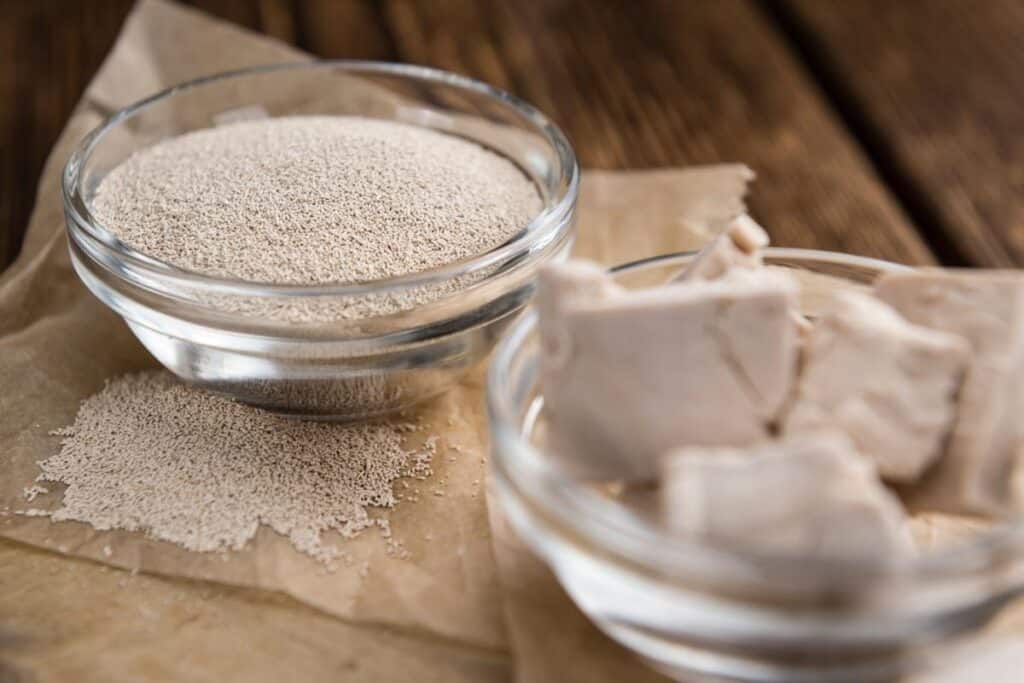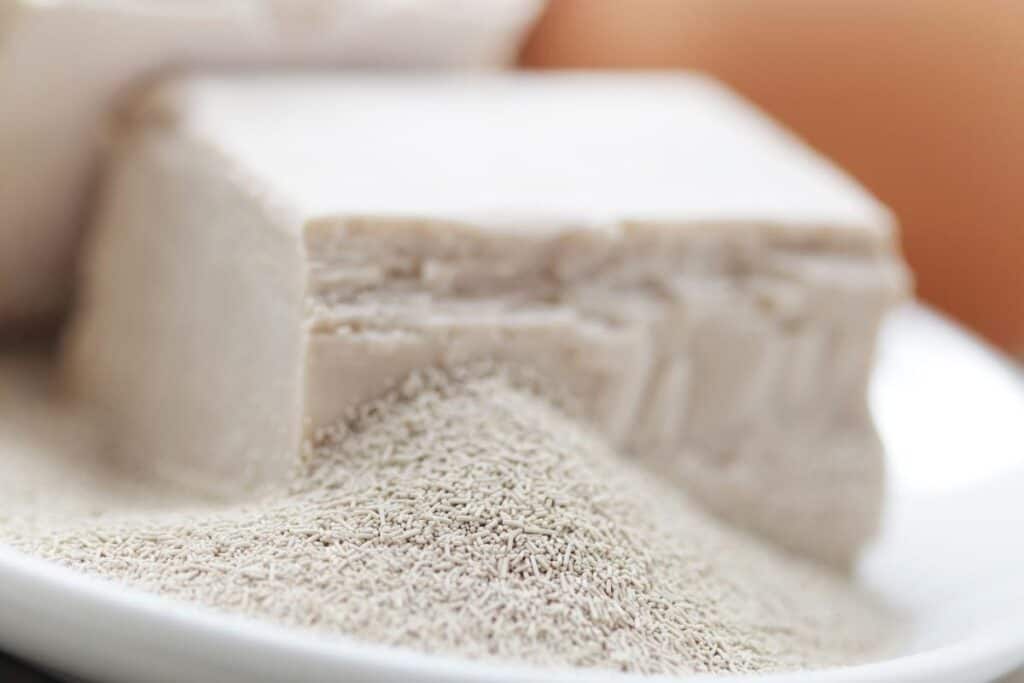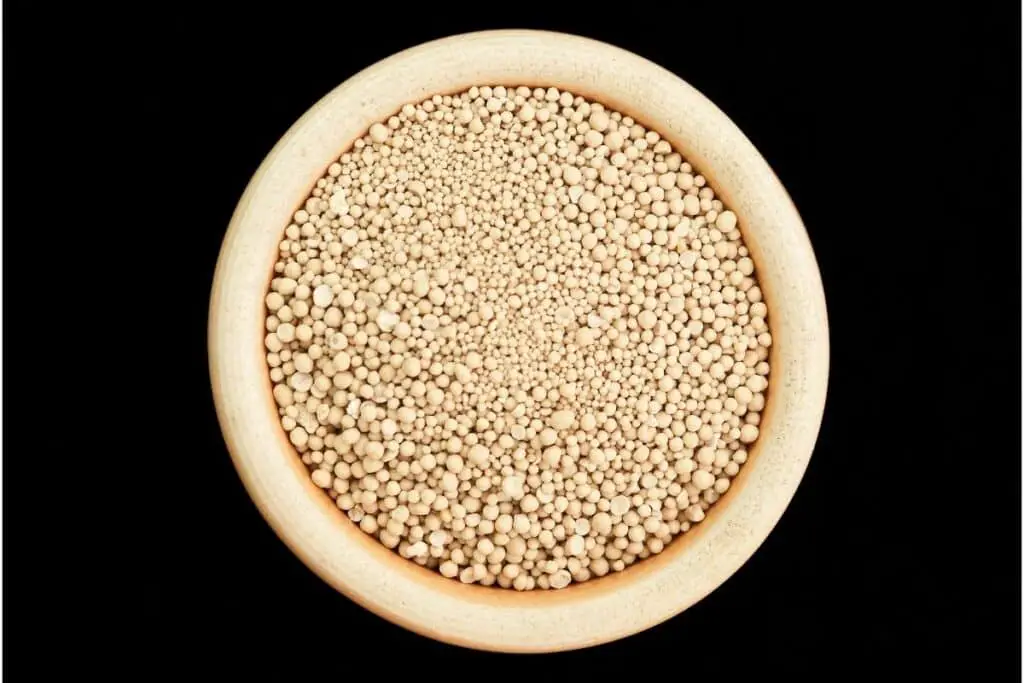We would open with a joke about the yeast, but those are few and far to come by. Instead, we will simply introduce the topic to you so that you can learn more about this fascinating fungus.
Yeast is a frightfully complicated topic, but absolutely critical for bakers. So, let us begin by asking the most obvious question first. What is it?

What Is Yeast?
You might be surprised to know that it is actually a single-celled fungus that is egg-shaped that you can only see under a microscope. If you were to weigh out one gram it would take twenty BILLION yeast cells to make that amount.
In order to grow and develop yeast cells must digest food because this is their means of obtaining energy.
For example, when you are baking leavened bread the yeast will start to ferment the sugars in the flour. This process will release carbon dioxide which cannot escape the dough because it is stretchy and kind of elastic.
So, when the sugar releases this carbon dioxide, that gas cannot escape, and that is why the dough starts to rise.
But yeast is not only used for making bread, it is also a key component in beer making. In fact, it is the yeast that starts eating the sugar and produces carbon dioxide which in turn creates alcohol. Interesting, right?
Different Names For Yeast
Yeast does not particularly go by different names, in the English language at least. But there are a ton of synonyms that are related to the word. For example:
- Fungus
- Ferment
- Leaven
- Zyme
At the end of the day, yeast is a fungus that is used to ferment sugars when certain products are being made.
Different Types Of Yeast
There are five basic types. Each one is used in different ways.
- Pizza Yeast or Bread Machine Yeast – Bread machine yeast is very similar to instant yeast, the main differences are the additives.
It is intended to be added directly to dry ingredients, but it can be proofed if you would like to follow this step. Bread machine yeast does not do well with long and cold-proofed dough. - Fresh Yeast – This is a very niche product that is not always available everywhere. It is something that more professional bakers or brewers tend to use.
- Instant Yeast – This type is very similar to active dry yeast. The main difference is that this product does not have a protective coating. Without the coating, it can be added directly to dry ingredients without being proofed in warm water.
If you would like to proof instant yeast, you can. Having the option to follow this step can make it easier to follow recipes that call for yeast to be proofed. - Rapid Rise Yeast – A rapid rise yeast is an instant yeast that has a coat of enhancers that give it a quicker and more energetic activation instantly. This type should be added to dry ingredients and is not designed to be proofed.
Pro tip: don’t use this one for cold-proofing. - Active Dry Yeast – This is the traditional yeast that your grandmother might have used. Before you use it you must activate it with warm water, this is called proofing.
When you are proofing, you must be careful not to use water that is too hot as this can easily kill your yeast and water that is too cold can mean that your yeast will take way too long to rise. It’s a fine line….
What Is The Difference Between Cake and Dry Yeast?

Cake yeast is a form of fresh yeast which is most often sold as a crumbly yet dense cake. It is used as a leavening agent for bread dough.
But, cake yeast is generally very perishable and because of this, it must be used quite quickly. If you want to prolong its life you can freeze it. It is most commonly used by professional bakers.
Dry yeast is essentially a dehydrated form of baker’s yeast and does not need to be refrigerated in order to stay usable. It has a very long shelf life and can be stored at room temperature.
The main difference between these two is the amount of time that they stay fresh and the fact that professionals tend to use the cake form as opposed to dry.
What Is The Difference Between Active Dry And Instant Yeast?
The biggest difference between active dry and instant yeast is the amount of moisture within them. Active dry will need to be dissolved in a liquid before it can be mixed with other ingredients. But, instant can be put straight in with dry ingredients.
How Is Yeast Made?
Yeast that is commercially produced is fed with molasses which is a nutritious by-product from the process of refining sugar. The yeast is put in large tanks and is fed molasses. As it ferments the tank begins to fill up with yeast.
It is harvested when the tank fills up, the product will be a liquid that is an off-white color and is known as cream yeast. It is further processed later on.
How Is Dry Yeast Made?
Dry yeast is made by adding wild yeast to molasses and starch. Over time a kind of sludge is made, which is then dried and granulated. When the yeast is dry it pauses the active cells part way through the fermentation process.
How To Make Your Own Yeast At Home
Yeast is easy to make from the comfort of your own home. All you need are the right ingredients, a set of instructions you can easily follow, and you will be well on your way.
We found a great recipe you can follow on ‘The Survivalist Mom’:
Let’s begin with the ingredients and items you will need to make this fruit yeast.
- Raisins – The recipe highly recommends raisins, but you can use other fruits if you so wish. As long as the fruit you pick has not been washed or waxed it should work well.
- Water – The water you use should be filtered, bottled, or clean. The only thing you need to be aware of is the content of chlorine in the water as it can kill your product.
- Glass Jar – Purchase a jar that is 24 oz or larger and sterilize it with hot water. Once it is sterilized, leave it to completely dry before you use it.
Step 1 – Add about four tablespoons of raisins and a few tablespoons of honey or sugar to your glass jar.
Step 2 – Add water to your glass jar and fill it about ¾ of the way. Put the lid on the jar and do not tighten the lid as you will need some air to escape during the process.
Step 3 – Keep the jar somewhere that will keep it at room temperature. It is important that it does not get too cold as the yeast will die if the temperature gets too low.
Step 4 – Over the course of the next three to four days, stir the contents of your jar at least once a day.
Step 5 – When you start to see bubbles at the rip of the jar, and you can smell that telltale fermented scent you will know that you have yeast. Also, the raisins should be floating at this point.
Step 6 – You should be done at this point. Place your masterpiece in the refrigerator.
There are several recipes out there. On The Survivalist Mom’s website, you can pick between a few recipes if this one does not work for you.
History Of Yeast

We have known about yeast for centuries. To our knowledge, it goes back over 5,000 years. We can even trace it back to ancient Egyptians who used it to make their bread. But, they did not make yeast as we know it today.
They ignored the fermentation process and believed that this biological process was a miracle.
It was said that in the first century AD the first bread as we know it was made using yeast. It was produced in Gaul and Iberia when they used beer foam.
How Did They Make It In The Old Days?
We actually do not know when exactly our ancient ancestors made bread using yeast. Some records show us that in Ancient Egypt for example they might have mixed flour meal and water together and left it a little longer than they intended on a hot day.
This must have been enough time for the fermentation process to occur and that is how they may have started making yeast for their bread.
Back in the 19th century, they used specially brewed fragments. These ferments were often made up of flour, mash, grain, or even boiled potatoes. Hops were also included so that the yeast did not become overly sour.
How Do You Activate Yeast?
Yeast is quite simple to activate. All you have to do is dissolve some sugar in warm water, add the dried active yeast and whisk it into the water. Leave the mixture in a warm place and wait for the surface to be covered in a froth.
Most often this will take about 15 minutes. You will need to whisk again thoroughly and then use mixture. This should be the total amount of water you use in the recipe.
Is Yeast Alive Or Dead?
Yeast is alive. However, it has no brain, no heart, no lungs, no stomach, no bones, and no blood. It is just a single-celled organism. It is very small and looks like a tiny white blob. It’s actually a kind of fungus that can only be seen through a microscope.
Does It Go Bad?
Yes, because it is alive at it can easily expire if it is not stored properly or it reaches its sell-by date. If you store it properly you could even extend the expiration date by four months.
Does Yeast Go Bad If Not Refrigerated?
If stored improperly, it could go bad. In fact, it could go bad as soon as two days. So, always refrigerate!
Is It Okay To Use Expired Yeast?
Yes, expired is fine. It is still viable, but it will not ferment as well. It will give off less carbon dioxide gas, and it will not rise as high. That being said, you should not expect too much from expired product.
What Happens To Dead Yeast?
Dead is dead. It cannot be revived. However, it is still edible. You can eat it by itself or mix it with other foods. It is safe to consume. The problem is that it is not going to smell good.
Also, the texture will be different. If your yeast has perished it will not produce any bubbles and the water will be stagnant. If it dies during the baking process your dough will simply not rise. You will have to start a new batch and new bread dough and start the process all over again.
Can Yeast Be Frozen?
Yes. You should put it in an airtight container and leave it in the freezer until frozen solid. Then, transfer it to a baggie or plastic wrap and freeze it again.
Does Yeast Survive Baking?
No, yeast will die when it reaches temperatures between 130 and 140 degrees Fahrenheit. When you bake your bread it will probably be at an even higher temperature such as 200 degrees Fahrenheit. So, your yeast will almost certainly be dead after the baking process.
At What Temp Is Yeast Killed?
Yeast is killed when it is exposed to temperatures that are between 130 degrees Fahrenheit and 140 degrees Fahrenheit.
Why Does It Float?
When yeast dough has just started to rise it will sink if it is dropped in water. This is because the process of fermentation and the production of carbon dioxide has not yet started. The longer you leave it in the dough the more gas is trapped, and eventually it becomes lighter than water and will float to the surface.
What If Yeast Doesn’t Float?
If your yeast does not float you can remove about ½ of the leaven and add more water and flour. After about two to three hours your dough should float.
What Is A Substitute For Yeast?
These days there is a very obvious alternative for: Baking powder. While it will get the job done and your dough will rise with baking powder it will not be as distinct as our yeasty friend.
